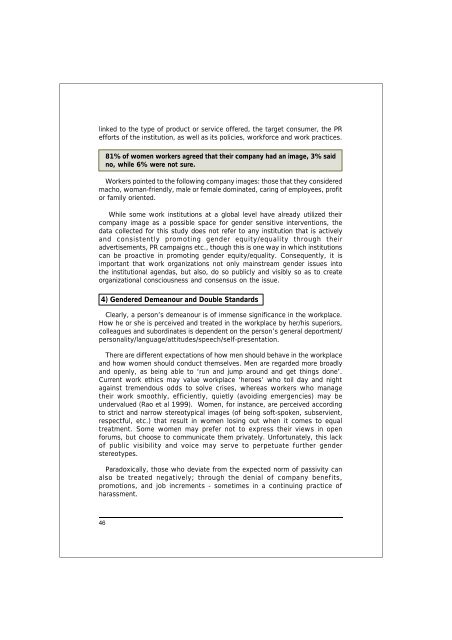Beyond Glass Ceilings and Brick Walls - International Labour ...
Beyond Glass Ceilings and Brick Walls - International Labour ...
Beyond Glass Ceilings and Brick Walls - International Labour ...
Create successful ePaper yourself
Turn your PDF publications into a flip-book with our unique Google optimized e-Paper software.
linked to the type of product or service offered, the target consumer, the PR<br />
efforts of the institution, as well as its policies, workforce <strong>and</strong> work practices.<br />
81% of women workers agreed that their company had an image, 3% said<br />
no, while 6% were not sure.<br />
Workers pointed to the following company images: those that they considered<br />
macho, woman-friendly, male or female dominated, caring of employees, profit<br />
or family oriented.<br />
While some work institutions at a global level have already utilized their<br />
company image as a possible space for gender sensitive interventions, the<br />
data collected for this study does not refer to any institution that is actively<br />
<strong>and</strong> consistently promoting gender equity/equality through their<br />
advertisements, PR campaigns etc., though this is one way in which institutions<br />
can be proactive in promoting gender equity/equality. Consequently, it is<br />
important that work organizations not only mainstream gender issues into<br />
the institutional agendas, but also, do so publicly <strong>and</strong> visibly so as to create<br />
organizational consciousness <strong>and</strong> consensus on the issue.<br />
4) Gendered Demeanour <strong>and</strong> Double St<strong>and</strong>ards<br />
Clearly, a person’s demeanour is of immense significance in the workplace.<br />
How he or she is perceived <strong>and</strong> treated in the workplace by her/his superiors,<br />
colleagues <strong>and</strong> subordinates is dependent on the person’s general deportment/<br />
personality/language/attitudes/speech/self-presentation.<br />
There are different expectations of how men should behave in the workplace<br />
<strong>and</strong> how women should conduct themselves. Men are regarded more broadly<br />
<strong>and</strong> openly, as being able to ‘run <strong>and</strong> jump around <strong>and</strong> get things done’.<br />
Current work ethics may value workplace ‘heroes’ who toil day <strong>and</strong> night<br />
against tremendous odds to solve crises, whereas workers who manage<br />
their work smoothly, efficiently, quietly (avoiding emergencies) may be<br />
undervalued (Rao et al 1999). Women, for instance, are perceived according<br />
to strict <strong>and</strong> narrow stereotypical images (of being soft-spoken, subservient,<br />
respectful, etc.) that result in women losing out when it comes to equal<br />
treatment. Some women may prefer not to express their views in open<br />
forums, but choose to communicate them privately. Unfortunately, this lack<br />
of public visibility <strong>and</strong> voice may serve to perpetuate further gender<br />
stereotypes.<br />
Paradoxically, those who deviate from the expected norm of passivity can<br />
also be treated negatively; through the denial of company benefits,<br />
promotions, <strong>and</strong> job increments - sometimes in a continuing practice of<br />
harassment.<br />
46
















